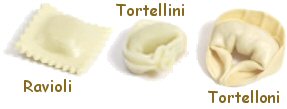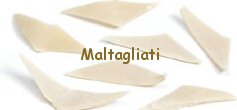Homemade Pasta
See further down the page for instructions on shaping the pasta once it is mixed.
Egg Pasta
- 2 c. to 1/2 lb. flour
- 2 eggs
- pinch salt (optional)
Different recipes say to use between 1 and 2 cups of flour. [Obviously, experimentation is in order.]
Pour the flour onto a flat cool work surface, preferably marble, into a mound shape " a fontana". Make a deep dent in the top and break in the eggs. With your fingers or with a fork, gently mix in the eggs with the flour. If you use a fork do not mix vigourously as you should not get air into the mixture. When all the egg has been absorbed into the flour, knead the dough for 15/20 minutes until it is firm and tiny bubbles appear on the surface. Form a ball with the dough and flatten it slightly with the palm of your hand. Using a rolling pin, start flattening the pasta out, then roll it out into a thin even sheet. Work slowly and rythmically.
Makes enough for 4 servings.
Top of Page
Durum Flour Pasta
- 2 c. to 1/2 lb. flour
- salt
- warm water
Pour the flour onto a flat cold clean surface into a mound shape and make a dent in the middle, in which you will put a pinch of salt. Spoon in a little warm water at a time and work the flour with your fingers, then the palms of your hands. Add enough water for the dough to form a smooth firm paste. Knead for a few minutes, working slowly and rythmically, then roll out with a rolling pin into one large single thin sheet. Let it dry for an hour or two so that it shrinks a bit.
Makes enough for 2 servings.
Top of Page
Egg & Oil Pasta
This recipe was found at Cooks.com.
- 4 c. flour
- 4 Tbsp. olive oil
- 4 eggs
- 1/2 tsp. salt
Pour flour onto a large bread board and form into a mound with a well in the center. Beat eggs, oil, and salt together and pour into well. Mix with fork, blending some amounts of the surrounding flour while mixing. When dough becomes stiff, knead in remaining flour with hands. A small amount of flour may be leftover.
Roll dough into a ball and coat with a few drops of olive oil to keep dough moist. Place dough into a bowl and cover with a moist towel. Let dough rest for 20 minutes. Cut into manageable portions. Flatten each piece on bread board before running through thickest setting on pasta machine. Run dough through machine 2-3 times at each setting until dough is thin enough for the specific use.
At this point, pasta may be cooked immediately, frozen or dried on a rack. NOTE: Dried homemade pasta is very fragile, handle with care.
Place fresh, frozen, or dried pasta into boiling, salted water to which a few drops of olive oil have been added. Cook until tender, usually 3-5 minutes.
Top of Page
Green Pasta
This recipe was found at Italianfood.About.com.
This is the most classic color, and gives rise to pasta paglia e fieno (straw and hay) -- a combination of green and yellow tagliatelle, which is often served with cream sauces
or salsa ai funghi (mushroom sauce). Green pasta is also an excellent alternative if you're making lasagna or ravioli.
- 1 lb. flour
- 8 oz. raw spinach
- 3 eggs
- pinch salt
Wash the spinach well, shred it coarsely, and heat it in a pot with just the water that sticks to the leaves. Add a pinch of salt and stir it until it is completely wilted (5 minutes), then let it cool and squeeze it well to remove all the moisture you can.
Blend the spinach and combine it with the other ingredients when you make the dough.
Top of Page
Red Pasta
This recipe was found at Italianfood.About.com.
The proportions are similar to those for green pasta.
- 1 lb. flour
- 10 oz. carrots
- 3 eggs
- 1 Tbsp. tomato paste
- pinch salt
Peel the carrots, dice them, and simmer them until soft in lightly salted water. Drain them well, blend them, add the tomato paste to the mixture, and heating it pot, stirring constantly, until it has become quite firm. Combine the mixture with the other ingredients when you make the dough.
If you want the pasta really red you can dispense with the carrots and simply cook down a tube of tomato paste, though in this case the resulting pasta will be rather acidic and will require something along the lines of a cream sauce to balance it.
Top of Page
Brown Pasta
This recipe was found at Italianfood.About.com.
This is a comparatively new addition to the pasta cornucopia, and is made with powdered baking (unsweetened) chocolate.
- 1 lb. flour
- 3 oz. powdered baking chocolate
- 4 eggs
- pinch salt
Combine all the ingredients, and make pasta as you normally would. Contrary to what you might expect, it's not sweet because baking chocolate. It will work quite nicely with rich game-based pasta sauces.
Top of Page
Cheese Pasta
This recipe was found at Italianfood.About.com.
In terms of color this really isn't that different from regular, but it is a pleasant change of pace.
- 1/2 lb. flour
- 1/2 lb. grated Parmigiano
- 3 eggs
You shouldn't need salt, due to the salt content of the Parmigiano. Combine the ingredients and proceed as normal, seasoning the finished pasta with unsalted butter and sage or a light tomato sauce.
One warning: because of the cheese, this pasta doesn't keep well.
Top of Page
Orange Pasta
This recipe was found at Italianfood.About.com.
Not carrot this time, but squash: Pick one with orange flesh (pumpkin will also work).
- 1 lb. flour
- 1 lb. squash
- 2 eggs
- pinch salt
Peel and dice the squash, discarding seeds and strings, and boil the pieces in lightly salted water for about a half hour. Drain the pieces well, blend them, and should the paste be too liquid, heat it again, stirring briskly, until it has thickened. Use the paste to make the pasta.
Top of Page
Speckled Pasta
This recipe was found at Italianfood.About.com.
These are a surprising delight, and since the strengths of herbs vary from time to time, will never be quite the same from batch to batch.
- 1 lb. flour
- 1/4 c. or to taste finely minced fresh herbs, including sage, parsley, rosemary, thyme, and whatever else suits your fancy
- 4 eggs
- pinch salt
The exact volume of herbs will vary depending upon the herbs you chose and their potency. In any case, wash them well, pat them dry, strip the leaves from the stems, and mince the leaves.
Combine the ingredients and make the pasta. The best sauce here will be unsalted butter, and a light dusting of grated Parmigiano.
Top of Page
Lemon Pasta
This recipe was found at Italian Food Forever.
The purpose of making flavored pasta is to add a touch of subtle flavor and color, so you donít want to over do it. Just remember flavored pasta should enhance a dish, not over power it. The two main sources for flavorings are usually vegetable purees and herbs. The following are suggested additions to produce many types of colored pasta dough. Try one of these, or experiment on your own. All recipes use unbleached all-purpose flour and extra-large eggs, with just a pinch of salt.
- 2-1/2 c. flour
- 3 eggs
- 2 Tbsp. grated lemon peel
- pinch salt
I sometimes add black pepper to this and serve with a simple shrimp sauce.
Top of Page
Shaping Pasta

Lasagna
Cut large squares or rectangles about 7/8cm/3 in. with a knife or pastry cutter. Usually half cooked in boiling water, layered in a baking dish with a meat or vegetable sauce and white sauce, and baked to finish the cooking.
Ravioli
Roll out the pastry and cut into long strips wide enough to be folded over (4"/8 cm). Place a little filling at regular intervals in a row along the top of the pasta strip; there must be enough space between them to make the edges of the ravioli. Fold over the bottom strip, press down between each filling, then separate each raviolo by cutting with a pastry cutter. Press down on the edges with your fingers to close them well. It is advisable to keep the pasta sheet covered with cling film while you are making the ravioli so that it does not dry out too much. Boil and remove with a skimmer, serve with butter or other sauce.

Tortelloni
Cut out disks about 2-inches diameter with a glass or pastry shape. Place a little filling on one disk then place another on top and press down on the edges with your fingers to close them well. It is advisable to keep the pasta sheet covered with cling film while you are making the tortelloni so that it does not dry out too much. Boil and remove with a skimmer, serve with butter or other sauce.
Tortellini
Cut out 1-inch squares. Place a little filling in the middle of each and fold the pasta over diagonally to form triangles. Press down on the edges to stop the filling coming out during the cooking. Fold the two tips around the index finger and press them together with your thumb.

Tagliolini, tagliatelle, papardelle
Let the pasta dry a little. Roll it from the outside towards the middle to form two parrallel rolls. Cut the roll crosswise into strips whose thickness will determine whether they are tagliolini, tagliatelle or papardelle. Slip a long knife under the middle and lift up the strips so that they unravel. Lay them out to dry before cooking. This pasta absorbs the sauce wonderfully.

Maltagliati
Form a loose roll with the pasta sheet. With a sharp knife cut first diagonally and then horizontally, alternating. When you unravel the pasta it will form irregular rectangles. Often used for "pasta e faggioli" or with "minestrone".
Top of Page
|

